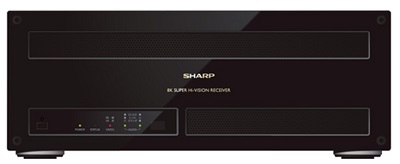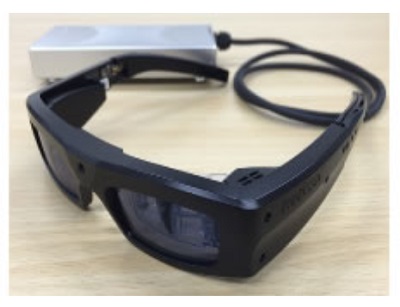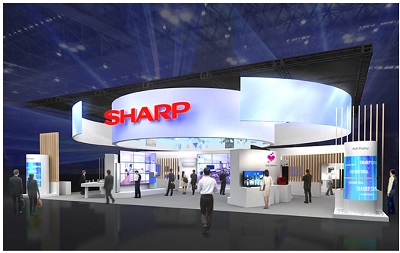CEATEC or Combined Exhibition of Advanced Technologies, the Japanese consumer electronics show that presents technology and its contribution to society, is taking place in Chiba, Japan this week. Always the place to first see new products but also research trends. The main trend and theme is the internet of things, how technology is connected and integrated in people's lifes.
In UHD there is Sharps new 4K/8K satellite receiver for the SHV test broadcast on the BS 17 satellite. The advanced wideband satellite digital broadcast receiver received Minister of Internal Affairs and Communications (MIC) Award at CEATEC.

Sharp's award-winning broadcast receiver was developed as the world's first dedicated equipment for receiving 8K test broadcasting, which started in August 2016. For the Olympic demo's NHK used what appears to be the same large prototype box. When connected to Sharp's LV-85001 8K monitor, 33-megapixel ultra-high-definition images with 16 times the resolution of full HD can be displayed. The receiver can also receive 4K multichannel broadcasts, in which multiple programs are broadcast at the same time. It also supports 22.2-channel surround sound, though that requires outboard amplification, the 22.2 immersive/3D audio has been an integral part of the NHK led SHV (Super Hi-Vision) programme for 8K broadcasts.
Sharp said it will continue the development of equipment for next-generation 8K broadcasting, in anticipation of the launch of full-scale 8K broadcasts slated to begin in 2018. At the show it will also show an 8K monitor that will show computer-generated 8K-resolution video that will give visitors a chance to experience the next generation of finely detailed ultra-high-definition images. And Sharp's unique Free-Form Display (FFDs) incorporating its IGZO LCD technology.

Fujitsu Limited and its ten year old spin-off, QD Laser, Inc.'s Retinal Imaging Laser Eyewear was also awarded by the CEATEC AWARD Review Panel. The Retinal Imaging Laser Eyewear Technology offers an array of advantages not available with conventional head mounted displays (HMD), including a focus-free feature that eliminates the need for the user to adjust eye focus, and its pursuit of universal design for a natural external appearance, with no protruding parts. It also holds the potential of becoming an alternative technology, with support for low vision eyesight, augmented and virtual reality and other sophisticated functions.
Retinal Imaging Laser Eyewear uses laser technology to directly project images onto the retina from a miniature projector. The user can view images from an embedded camera or digital data from external input. The independently developed optical system has little impact on visual acuity or eye focus, and with a design that has the projector mounted inside the frame, there are no protruding parts.
As a transparent-type HMD, in addition to augmented reality and smart glasses applications, it is mainly being developed as a medical device for the purpose of supporting the visual function of people with low vision (visually impaired but not completely blind), who have irregularities in the anterior part of their eyes.
The in-eye display was developed with the support of two goverment grant programmes. And though the laser beam is considered to be safe under reasonably foreseeable use according to Class 1 in the IEC60825-1 standard, its application in supporting visual function has not yet received approval under Japan's Pharmaceutical and Medical Device Act, so it cannot be sold or distributed. A proper show item promoting the state-of-the-art.

Sharp is also joining the IoT wave at CEATEC, under the theme of "IoT by Sharp - A New Way of Living," Sharp will present its AIoT Smart Home. Sharp says it is in the process of applying AIoT - a fusion of AI (artificial intelligence) and IoT - to its consumer electronics. By having AI learn about a user's preferences and lifestyle, AIoT consumer electronics can not only optimize existing functions, but also autonomously suggest various other functions and services according to the usage situation. This will make users' lives even more comfortable and convenient. Sharp will introduce the world of its AIoT Smart Home through presentations and hands-on demonstrations through wich visitors will get a sense of the futuristic lifestyles made possible by an AIoT Smart Home fitted with AIoT consumer electronics. The Artificial Intelligences of these cloud-connected smart appliances evolve day by day to match user preferences and lifestyles, thereby making users' lives more comfortable and convenient, Sharp claims.
Mitsubishi Electric said it will introduce its latest products and technologies that support the society of the future, with a focus on IoT technology deployed in areas such as residence, manufacturing plants, transportation and other aspects of society. Individual demonstrations will include a user interface for voice-activated drawing, the hands-on demonstration shows spoken words displayed along where a finger is traced on a tablet screen.aimed at helping people transcend hearing impairment or communicate in foreign languages.
Also on show a high-precision air-quality sensor that alerts to the presence of PM2.5 microscopic air pollutants.
Introducting the e-F@ctory concept, the company’s integrated factory automation solution, demonstrates the company’s new maintenance and diagnosis service targeting laser-processing machines for cutting sheet metal, utilizing IoT to demonstrate the operational status of the machines on a tablet.
Next-generation driving-assistance technologies featuring a hands-on 3D head-up display, human machine interface demonstration using a multi-bonding display, and a demonstration on driver sensing technology that enables cars to detect the status of the driver.
Sharp will also introduce new applications for RoBoHoN its Robotic Mobile Phone, targeting corporate customers in the service robot field.
https://www.youtube.com/watch?v=HfiQfKf962s
And Toyota is launching the mini version of the Kiribo personal companion robot, ahead of an early 2017 commercial availability, of the 10centimeter/4 inches tall mini robot, at the equivalent of $400,-.

"Kirobo Mini could help driving become a physically and emotionally transformative experience. After all, Kirobo’s name derives from the Japanese word for ‘hope', and we believe he’s filled with exciting possibilities…", Toyota said in a statement.

In UHD there is Sharps new 4K/8K satellite receiver for the SHV test broadcast on the BS 17 satellite. The advanced wideband satellite digital broadcast receiver received Minister of Internal Affairs and Communications (MIC) Award at CEATEC.

Sharp's award-winning broadcast receiver was developed as the world's first dedicated equipment for receiving 8K test broadcasting, which started in August 2016. For the Olympic demo's NHK used what appears to be the same large prototype box. When connected to Sharp's LV-85001 8K monitor, 33-megapixel ultra-high-definition images with 16 times the resolution of full HD can be displayed. The receiver can also receive 4K multichannel broadcasts, in which multiple programs are broadcast at the same time. It also supports 22.2-channel surround sound, though that requires outboard amplification, the 22.2 immersive/3D audio has been an integral part of the NHK led SHV (Super Hi-Vision) programme for 8K broadcasts.
Sharp said it will continue the development of equipment for next-generation 8K broadcasting, in anticipation of the launch of full-scale 8K broadcasts slated to begin in 2018. At the show it will also show an 8K monitor that will show computer-generated 8K-resolution video that will give visitors a chance to experience the next generation of finely detailed ultra-high-definition images. And Sharp's unique Free-Form Display (FFDs) incorporating its IGZO LCD technology.

Fujitsu Limited and its ten year old spin-off, QD Laser, Inc.'s Retinal Imaging Laser Eyewear was also awarded by the CEATEC AWARD Review Panel. The Retinal Imaging Laser Eyewear Technology offers an array of advantages not available with conventional head mounted displays (HMD), including a focus-free feature that eliminates the need for the user to adjust eye focus, and its pursuit of universal design for a natural external appearance, with no protruding parts. It also holds the potential of becoming an alternative technology, with support for low vision eyesight, augmented and virtual reality and other sophisticated functions.
Retinal Imaging Laser Eyewear uses laser technology to directly project images onto the retina from a miniature projector. The user can view images from an embedded camera or digital data from external input. The independently developed optical system has little impact on visual acuity or eye focus, and with a design that has the projector mounted inside the frame, there are no protruding parts.
As a transparent-type HMD, in addition to augmented reality and smart glasses applications, it is mainly being developed as a medical device for the purpose of supporting the visual function of people with low vision (visually impaired but not completely blind), who have irregularities in the anterior part of their eyes.
The in-eye display was developed with the support of two goverment grant programmes. And though the laser beam is considered to be safe under reasonably foreseeable use according to Class 1 in the IEC60825-1 standard, its application in supporting visual function has not yet received approval under Japan's Pharmaceutical and Medical Device Act, so it cannot be sold or distributed. A proper show item promoting the state-of-the-art.

Sharp is also joining the IoT wave at CEATEC, under the theme of "IoT by Sharp - A New Way of Living," Sharp will present its AIoT Smart Home. Sharp says it is in the process of applying AIoT - a fusion of AI (artificial intelligence) and IoT - to its consumer electronics. By having AI learn about a user's preferences and lifestyle, AIoT consumer electronics can not only optimize existing functions, but also autonomously suggest various other functions and services according to the usage situation. This will make users' lives even more comfortable and convenient. Sharp will introduce the world of its AIoT Smart Home through presentations and hands-on demonstrations through wich visitors will get a sense of the futuristic lifestyles made possible by an AIoT Smart Home fitted with AIoT consumer electronics. The Artificial Intelligences of these cloud-connected smart appliances evolve day by day to match user preferences and lifestyles, thereby making users' lives more comfortable and convenient, Sharp claims.
Mitsubishi Electric said it will introduce its latest products and technologies that support the society of the future, with a focus on IoT technology deployed in areas such as residence, manufacturing plants, transportation and other aspects of society. Individual demonstrations will include a user interface for voice-activated drawing, the hands-on demonstration shows spoken words displayed along where a finger is traced on a tablet screen.aimed at helping people transcend hearing impairment or communicate in foreign languages.
Also on show a high-precision air-quality sensor that alerts to the presence of PM2.5 microscopic air pollutants.
Introducting the e-F@ctory concept, the company’s integrated factory automation solution, demonstrates the company’s new maintenance and diagnosis service targeting laser-processing machines for cutting sheet metal, utilizing IoT to demonstrate the operational status of the machines on a tablet.
Next-generation driving-assistance technologies featuring a hands-on 3D head-up display, human machine interface demonstration using a multi-bonding display, and a demonstration on driver sensing technology that enables cars to detect the status of the driver.
Sharp will also introduce new applications for RoBoHoN its Robotic Mobile Phone, targeting corporate customers in the service robot field.
https://www.youtube.com/watch?v=HfiQfKf962s
And Toyota is launching the mini version of the Kiribo personal companion robot, ahead of an early 2017 commercial availability, of the 10centimeter/4 inches tall mini robot, at the equivalent of $400,-.

"Kirobo Mini could help driving become a physically and emotionally transformative experience. After all, Kirobo’s name derives from the Japanese word for ‘hope', and we believe he’s filled with exciting possibilities…", Toyota said in a statement.
Comment